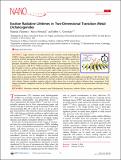| dc.contributor.author | Palummo, Maurizia | |
| dc.contributor.author | Bernardi, Marco | |
| dc.contributor.author | Grossman, Jeffrey C. | |
| dc.date.accessioned | 2016-05-18T15:28:36Z | |
| dc.date.available | 2016-05-18T15:28:36Z | |
| dc.date.issued | 2015-03 | |
| dc.date.submitted | 2015-02 | |
| dc.identifier.issn | 1530-6984 | |
| dc.identifier.issn | 1530-6992 | |
| dc.identifier.uri | http://hdl.handle.net/1721.1/102525 | |
| dc.description.abstract | Light emission in two-dimensional (2D) transition metal dichalcogenides (TMDs) changes significantly with the number of layers and stacking sequence. While the electronic structure and optical absorption are well understood in 2D-TMDs, much less is known about exciton dynamics and radiative recombination. Here, we show first-principles calculations of intrinsic exciton radiative lifetimes at low temperature (4 K) and room temperature (300 K) in TMD monolayers with the chemical formula MX[subscript 2] (X = Mo, W, and X = S, Se), as well as in bilayer and bulk MoS[subscript 2] and in two MX[subscript 2] heterobilayers. Our results elucidate the time scale and microscopic origin of light emission in TMDs. We find radiative lifetimes of a few picoseconds at low temperature and a few nanoseconds at room temperature in the monolayers and slower radiative recombination in bulk and bilayer than in monolayer MoS[subscript 2]. The MoS[subscript 2]/WS[subscript 2] and MoSe[subscript 2]/WSe[subscript 2] heterobilayers exhibit very long-lived (∼20–30 ns at room temperature) interlayer excitons constituted by electrons localized on the Mo-based and holes on the W-based monolayer. The wide radiative lifetime tunability, together with the ability shown here to predict radiative lifetimes from computations, hold unique potential to manipulate excitons in TMDs and their heterostructures for application in optoelectronics and solar energy conversion. | en_US |
| dc.description.sponsorship | Lockheed Martin | en_US |
| dc.language.iso | en_US | |
| dc.publisher | American Chemical Society (ACS) | en_US |
| dc.relation.isversionof | http://dx.doi.org/10.1021/nl503799t | en_US |
| dc.rights | Article is made available in accordance with the publisher's policy and may be subject to US copyright law. Please refer to the publisher's site for terms of use. | en_US |
| dc.source | MIT web domain | en_US |
| dc.title | Exciton Radiative Lifetimes in Two-Dimensional Transition Metal Dichalcogenides | en_US |
| dc.type | Article | en_US |
| dc.identifier.citation | Palummo, Maurizia, Marco Bernardi, and Jeffrey C. Grossman. “Exciton Radiative Lifetimes in Two-Dimensional Transition Metal Dichalcogenides.” Nano Lett. 15, no. 5 (May 13, 2015): 2794–2800. | en_US |
| dc.contributor.department | Massachusetts Institute of Technology. Department of Materials Science and Engineering | en_US |
| dc.contributor.mitauthor | Grossman, Jeffrey C. | en_US |
| dc.relation.journal | Nano Letters | en_US |
| dc.eprint.version | Author's final manuscript | en_US |
| dc.type.uri | http://purl.org/eprint/type/JournalArticle | en_US |
| eprint.status | http://purl.org/eprint/status/PeerReviewed | en_US |
| dspace.orderedauthors | Palummo, Maurizia; Bernardi, Marco; Grossman, Jeffrey C. | en_US |
| dspace.embargo.terms | N | en_US |
| dc.identifier.orcid | https://orcid.org/0000-0003-1281-2359 | |
| mit.license | PUBLISHER_POLICY | en_US |
